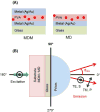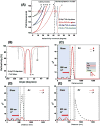Directional Emission from Metal-Dielectric-Metal Structures: Effect of Mixed Metal Layers, Dye Location and Dielectric Thickness
- PMID: 25844110
- PMCID: PMC4381343
- DOI: 10.1021/jp512174w
Directional Emission from Metal-Dielectric-Metal Structures: Effect of Mixed Metal Layers, Dye Location and Dielectric Thickness
Abstract
Metal-dielectric-metal (MDM) structures provide directional emission close to the surface normal, which offers opportunities for new design formats in fluorescence based applications. The directional emission arises due to near-field coupling of fluorophores with the optical modes present in the MDM substrate. Reflectivity simulations and dispersion diagrams provide a basic understanding of the mode profiles and the factors that affect the coupling efficiency and the spatial distribution of the coupled emission. This work reveals that the composition of the metal layers, the location of the dye in the MDM substrate and the dielectric thickness are important parameters that can be chosen to tune the color of the emission wavelength, the angle of observation, the angular divergence of the emission and the polarization of the emitted light. These features are valuable for displays and optical signage.
Keywords: Cavity-Mode-Coupled Emission; Directional Emission; Dispersion; Metal-Dielectric-Metal; Surface-Plasmon-Coupled Emission.
Figures










Similar articles
-
Directing fluorescence with plasmonic and photonic structures.Acc Chem Res. 2015 Aug 18;48(8):2171-80. doi: 10.1021/acs.accounts.5b00100. Epub 2015 Jul 13. Acc Chem Res. 2015. PMID: 26168343 Free PMC article.
-
Steering Fluorescence Emission with Metal-Dielectric-Metal Structures of Au, Ag and Al.J Phys Chem C Nanomater Interfaces. 2013 Aug 1;117(30):15798-15807. doi: 10.1021/jp4051066. J Phys Chem C Nanomater Interfaces. 2013. PMID: 25126154 Free PMC article.
-
Radiative decay engineering 7: Tamm state-coupled emission using a hybrid plasmonic-photonic structure.Anal Biochem. 2014 Jan 15;445:1-13. doi: 10.1016/j.ab.2013.10.009. Epub 2013 Oct 14. Anal Biochem. 2014. PMID: 24135654 Free PMC article.
-
Fluorescence Spectroscopy with Metal-Dielectric Waveguides.J Phys Chem C Nanomater Interfaces. 2015 Jul 16;119(28):16245-16255. doi: 10.1021/acs.jpcc.5b04204. Epub 2015 Jul 1. J Phys Chem C Nanomater Interfaces. 2015. PMID: 26523157 Free PMC article.
-
Tamm State-Coupled Emission: Effect of Probe Location and Emission Wavelength.J Phys Chem C Nanomater Interfaces. 2014 Sep 18;118(37):21558-21571. doi: 10.1021/jp506190h. Epub 2014 Aug 29. J Phys Chem C Nanomater Interfaces. 2014. PMID: 25247029 Free PMC article.
Cited by
-
Development and effects of tacrolimus-loaded nanoparticles on the inhibition of corneal allograft rejection.Drug Deliv. 2019 Dec;26(1):290-299. doi: 10.1080/10717544.2019.1582728. Drug Deliv. 2019. PMID: 30895841 Free PMC article.
-
Directing fluorescence with plasmonic and photonic structures.Acc Chem Res. 2015 Aug 18;48(8):2171-80. doi: 10.1021/acs.accounts.5b00100. Epub 2015 Jul 13. Acc Chem Res. 2015. PMID: 26168343 Free PMC article.
References
-
- Enderlein J, Ruckstuhl T. The Efficiency of Surface-Plasmon Coupled Emission for Sensitive Fluorescence Detection. Optics Express. 2005;13:8855–8865. - PubMed
Grants and funding
LinkOut - more resources
Full Text Sources
Other Literature Sources
